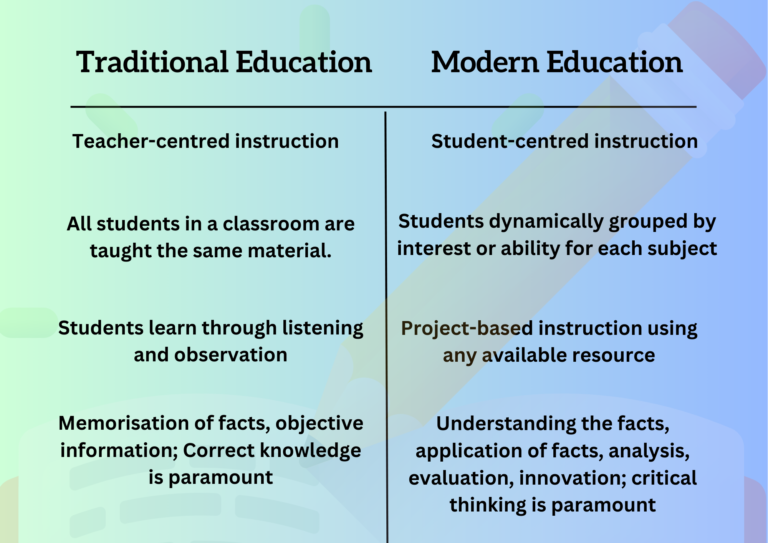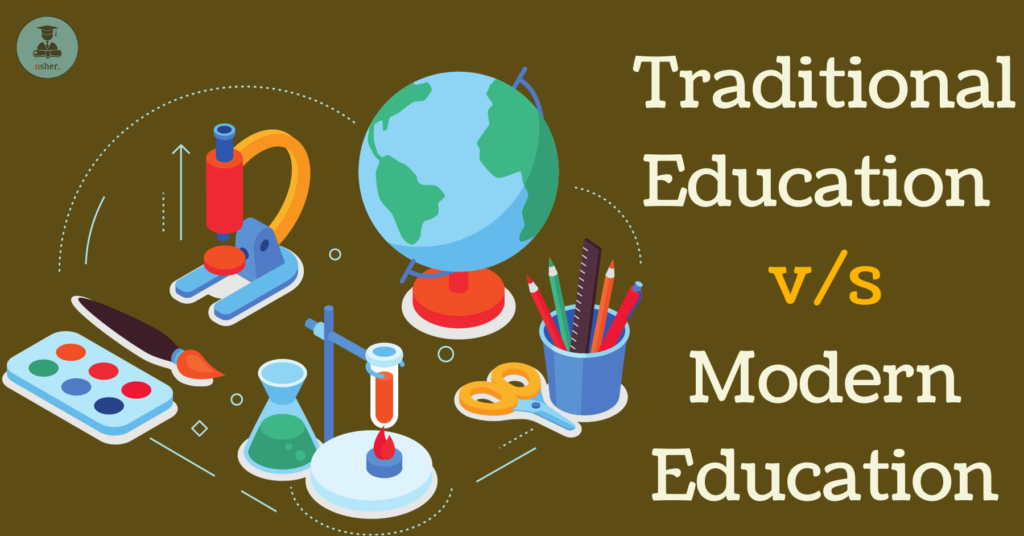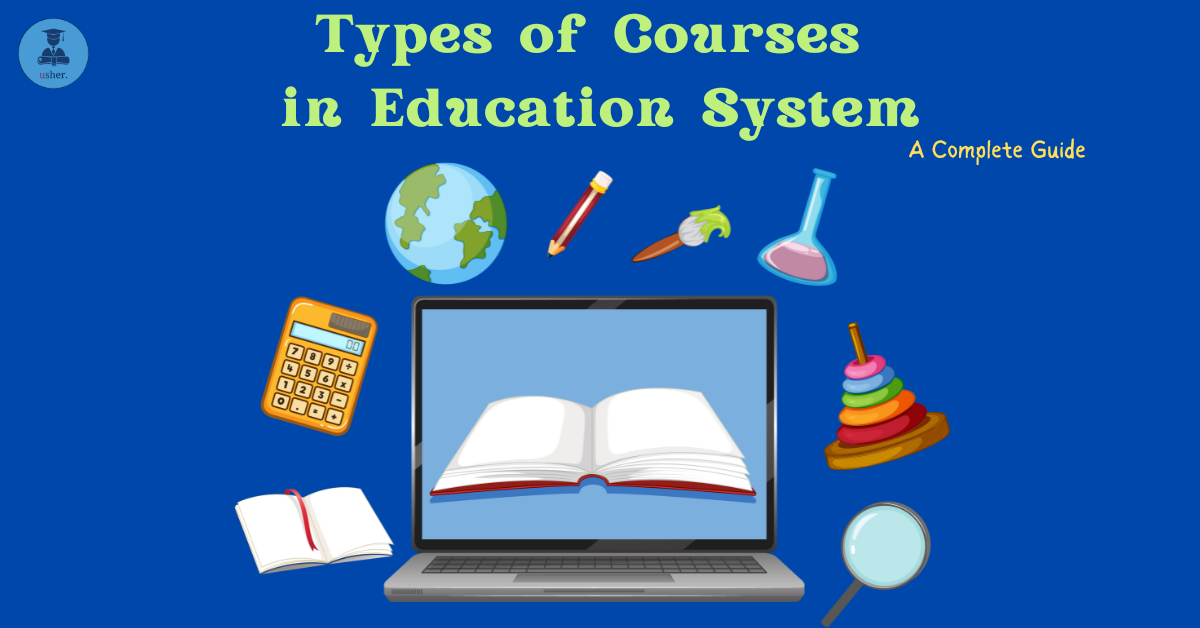The transmission of knowledge, skills, and character qualities is known as education.
Education is extremely important in a person’s life. It provides individuals with the knowledge, skills, and values required for personal and professional development.
We have seen changes in the syllabus, curriculum, teaching methods, techniques, methodology, and overall approach to education over the years.
When we talk about education, there are two main approaches that often come up for discussion: traditional education and modern education. Let’s explore the characteristics, strengths, weaknesses, and how we can blend the best of both worlds to provide a well-rounded education.
What is traditional education?
Traditional education, also known as conventional education, is a form of teaching methodology that society has traditionally used in schools. It has a structured classroom setting where teachers are the focal point of knowledge. Students follow a set curriculum, memorize facts, and often engage in rote learning.
Traditional education mainly focused on passing on values, manners and practice to the next generation. Students were taught about the customs and society they lived in.
Students simply sit in groups and listen to the teacher share their experiences. While there is no concept of written tests, it does involve some oral tests.
This type of education does not educate students about practical science, technology, or current events. It is mostly concerned with how children should develop socially.
Traditional education is associated with far more coercive elements than is now acceptable in most cultures.
Advantages of traditional education
Building a Knowledge Base:
Traditional education does well in laying a solid foundation of basic knowledge in subjects like math, science, history, and literature.
Instilling Discipline:
The structured setup of traditional education helps students develop discipline and time-management skills.
Respect for Authority:
It teaches students to respect authority figures, an important aspect of social integration.
Cultural Preservation:
Traditional education often incorporates cultural values, history, and traditions, helping in the preservation and dissemination of cultural heritage.
Disadvantages of traditional education
Creativity Takes a Back Seat:
Rote learning can stifle creativity and critical thinking, hindering the development of these crucial skills.
One-Size-Fits-All Approach:
The approach may not suit everyone, as each student has a unique learning style and pace.
Only theory with no practicality:
Traditional education can sometimes lack real-world application, focusing more on theoretical knowledge.
Limited Creativity and Innovation:
The structured nature of traditional education can stifle creativity and innovation. Students may feel confined to follow a set curriculum and not explore their unique ideas and perspectives, inhibiting their creative potential.
Uniform Learning Pace:
Traditional classrooms often follow a uniform learning pace, where all students are expected to grasp the material at the same rate. This approach doesn’t account for the diverse learning speeds and styles of individual students, potentially leaving some students behind or bored.
Inflexibility and Standardization:
The traditional education system tends to be inflexible in terms of adapting to the needs of individual students. The standardized curriculum may not cater to diverse learning styles, preferences, or special needs, leaving some students struggling to keep up.
Teacher-Centric Approach:
Traditional education typically places the teacher at the center of the learning process, with students being passive recipients of knowledge. This can discourage student engagement and active participation in their own learning journey.
Inhibits Critical Thinking:
Because traditional education often relies on rote memorization and standardized testing, it may not encourage critical thinking, problem-solving, or analytical skills. Students might prioritize exam-oriented learning rather than a deeper understanding of the subject matter.
This outdated education system paved the way for new and innovative approaches to learning, such as project-based learning and flipped classrooms. These methods prioritize active student engagement, critical thinking, and problem-solving skills, allowing students to take ownership of their education and apply their knowledge in real-world contexts. This type of education system, as we know it today, is called the modern education system.
What is modern education?
The current system of teaching and learning, which developed from traditional methods, is referred to as modern education. It emphasizes the use of technology, collaboration, and personalized instruction to cater to the diverse needs and interests of students. This approach recognizes the importance of equipping students with skills that are relevant in today’s rapidly changing world, such as digital literacy, adaptability, and creativity.
Alternate terms for modern education include progressive education and alternative education.
Advantages of modern education
Innovative Teaching Methods:
Modern education incorporates innovative teaching methods such as experiential learning, project-based learning, gamification, and interactive multimedia presentations. These methods make learning engaging and effective.
Personalized Learning:
Modern education recognizes the diverse learning styles and paces of individual students. It tailors learning experiences to meet the specific needs and interests of each student, enhancing understanding and retention.
Technology Integration:
The integration of technology in modern education enhances learning experiences. It provides access to a vast array of educational resources, online courses, interactive platforms, and multimedia tools, making learning more interactive, dynamic, and accessible.
Critical Thinking and Problem-Solving Skills:
Modern education emphasizes critical thinking, problem-solving, creativity, and analytical skills. Students are encouraged to question, analyse, and evaluate information, preparing them to adapt to complex real-world challenges.
Global Perspective and Cultural Awareness:
Modern education often promotes a global perspective, exposing students to diverse cultures, perspectives, and world issues. This fosters cultural awareness, empathy, and a broader understanding of the interconnected world.
Flexibility and Adaptability:
Modern education is flexible and adaptable to changes in society and the job market. It prepares students to be versatile, embrace change, and learn continuously throughout their lives.
Collaborative Learning and Teamwork:
Modern education encourages collaborative learning, group projects, and teamwork. Students learn how to work together, share ideas, and value diverse contributions, skills essential for success in professional environments.
Enhanced Communication Skills:
With increased emphasis on presentations, group discussions, and online collaborations, modern education cultivates strong communication skills, including both verbal and written communication, vital for effective interaction in the digital age.
Lifelong Learning and Skill Development:
Modern education emphasizes the importance of lifelong learning and skill development. It equips students with the ability to continuously update their knowledge and adapt to evolving industries and technologies.
Practical Application and Experiential Learning:
Modern education often includes hands-on experiences, internships, and real-world projects, allowing students to apply theoretical knowledge in practical settings, bridging the gap between academia and the workplace.
Disadvantages of modern education
Overdependence on Technology:
Modern education relies heavily on technology, which can lead to an overreliance on gadgets and digital platforms. This dependence may hinder students’ ability to think critically without the aid of technology.
Digital Divide:
Not all students have equal access to technology or the internet due to economic or geographical disparities. This creates a digital divide, where some students may not benefit from online learning opportunities, causing inequality in educational access.
Lack of Personal Interaction:
Online and remote learning, a hallmark of modern education, often lacks personal interaction with teachers and peers. This can affect students’ social skills, interpersonal relationships, and emotional well-being.
Reduced Attention Span and Multitasking:
Continuous exposure to technology can lead to shorter attention spans and a tendency to multitask. Students may struggle to focus on one task for an extended period, affecting their ability to deeply engage with educational material.
Loss of Traditional Teaching Values:
The shift towards modern education can sometimes lead to a loss of traditional teaching values, including face-to-face interaction, personal mentorship, and the human touch in education.

In conclusion, while technology has undoubtedly revolutionized the education system and opened up new opportunities for learning, it is important to recognize and address the potential drawbacks. By finding a balance between utilizing technology and preserving traditional teaching values, teachers and educators can ensure that students receive a well-rounded education that prepares them for the future while also fostering personal connections and deep engagement with the material. Ultimately, the goal should be to harness the power of technology while maintaining the human element in education.




